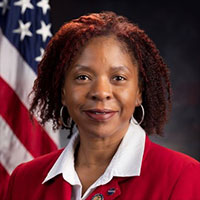Julie Williams-Byrd Chief Technologist, NASA Langley Research Center
Sessions
-
AIAA SciTech Forum 2021
-
AIAA SciTech Forum 2023

Julie Williams-Byrd is an electro-optics engineer at NASA’s Langley Research Center in Hampton, Virginia. As Langley’s Chief Technologist, Williams-Byrd advises the LaRC Office of Director and senior staff on technology matters and provides technical leadership for planning, management and evaluation of comprehensive, center-wide technology development activities with an emphasis on early stage technologies. She also leads and performs technology development related studies and performs data analysis for the NASA chief technologist at NASA Headquarters in Washington.
Prior to becoming chief technologist, she was a senior systems analysis in the Space Mission Analysis Branch (SMAB) in the Systems Analysis and Concepts Directorate. While in SMAB, Julie led and managed the integration function for a multi-center capability and technology team called the System Maturation Team (SMT). The SMT is an agency-wide team of subject matter experts that identify capability needs that will enable NASA’s human exploration missions. Under her leadership, the team identified capabilities and technologies needed for long-term human space exploration. Another accomplishment included the development of an innovative method to identify functional capabilities needed to enable human exploration missions. Julie communicated this innovative concept to capability and system development subject matter experts and introduced product formats that quantify the capabilities and identify capability performance gaps that enabled the Evolvable Mars Campaign (EMC) study missions. These formats saved development time. She performed the assessment of SMT capabilities, functions and performance metrics against human exploration mission goals and conceptual exploration architecture elements and design reference missions. These accomplishments -- a first of their kind -- are considered revolutionary, of exceptional technical merit and have provided significant impact for NASA Human Exploration and Operations Mission Directorate and Langley. The identification of these capabilities directly influences agency strategic investment decisions for human spaceflight initiates.
Julie led the capability and technology assessment and integration team (C&TAIT) in the Space Mission Analysis Branch at Langley. Her team provided capability and technology prioritization and assessment information to NASA HEOMD’s Advanced Exploration Systems Division (AESD) to assist agency decision makers with tactical and strategic decisions concerning capability and technology investments that would enable human space exploration. Accomplishments include performing capability and technology prioritization assessments for a variety of customers, integration of capabilities and technologies with system architecture, identification of enabling capability development metrics and technology portfolio defense. Because of the variety of customer objectives and requirements, all the prioritization processes were modified while maintaining robust and defensible technology prioritization.
Williams-Byrd also has extensive expertise in developing solid-state laser systems in LIDARS that perform remote sensing of the atmosphere. As an electro-optics engineer in the Active Sensor System Branch, Williams-Byrd led and oversaw the concept, definition, design, development, analysis and application of advanced electro-optics systems, solid-state lasers and laser and lidar systems related to active sensing of Earth atmosphere for research aircraft and space-flight missions for the center and agency. She provided project leadership for the development of advanced solid-state laser systems, sensors and lidar systems for center and agency programs -- including analysis of solid state laser materials and design, test, analysis and evaluation of these systems. She interacted with scientists and engineers at the national and international levels and performed a key role in the coordination and integrated planning of activities with other NASA centers, NASA Headquarters, industry, academia and other federal agencies.
Williams-Byrd earned bachelor’s and master’s degrees in physics from Hampton University in Hampton, Virginia. She is the author of numerous technical publications. She is committed to encouraging young scientists and engineers through mentoring and community outreach activities advocating careers in science, technology, engineering, arts and math (STEAM). She is featured on the NASA Modern Figures and Woman of NASA (WON) websites.
